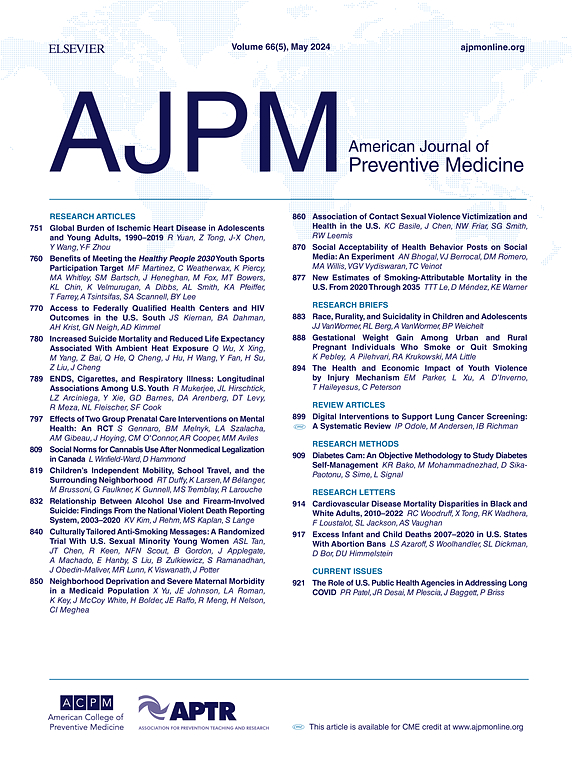人力资本不平等溢出:2010-2022年美国各县大学学历人口死亡率的纵向分析
IF 4.3
2区 医学
Q1 MEDICINE, GENERAL & INTERNAL
引用次数: 0
摘要
导读:我们知道县级教育程度会影响死亡率,但人们对这些影响在有学士学位和没有学士学位的人群之间的差异知之甚少。本研究考察了美国县级人力资本与有和没有学士学位的人口死亡率之间的关系,以及它在2010年至2022年间的变化情况。方法:收集2010-2022年全国3122个县(40,585个县年观察数据)的数据,采用固定效应负二项回归分析按受教育程度分层的死亡率。死亡率数据来自国家卫生统计中心多死因档案,县级人力资本以25岁及以上具有学士学位的人口的百分比来衡量。在2024年进行的分析中考虑了县级人口、经济和健康相关因素。结果:县域人力资本效应呈现发散效应。县BA人口每增加1%,BA患者的全因死亡率就会下降4.5%,而没有BA的患者的全因死亡率则会增加1.2%。在研究期间,这种差异有所缓和,主要是由于高人力资本国家BA持有者的保护作用减弱。这种模式在其他死因中也存在。结论:生活在高等教育地区的好处并没有均匀分布,这可能会加剧健康不平等。虽然县级人力资本对拥有学士学位的人仍然具有保护作用,但随着时间的推移,这种优势已经减弱,而对没有学士学位的人的不利影响已经稳定下来。本文章由计算机程序翻译,如有差异,请以英文原文为准。
Unequal Spillover of Human Capital: Longitudinal Analysis of Mortality Among Populations by College Degree in U.S. Counties, 2010–2022
Introduction
County-level educational attainment is known to affect mortality rates, but little is understood about how these effects differ between populations with and without a bachelor’s degree. This study examined the association between county-level human capital and mortality rates of populations with and without a bachelor's degree in U.S. counties, and how it changed between 2010 and 2022.
Methods
Assembling 2010–2022 data of 3,122 counties (40,585 county-year observations), this study used fixed-effect negative binomial regression to analyze mortality rates stratified by educational attainment. Mortality data came from the National Center for Health Statistics Multiple Cause of Death files and county-level human capital was measured as percentage of population aged 25 years and over with a bachelor's degree. County-level demographic, economic, and health-related factors were considered in the analysis conducted in 2024.
Results
County-level human capital showed divergent effects. A 1% increase in county bachelor's degree population corresponded to a 4.5% decrease in all-cause mortality for those with a bachelor's degree but a 1.2% increase for those without a bachelor's degree. Over the study period, this disparity moderated, primarily due to a weakening protective effect among bachelor's degree holders in high–human capital counties. This pattern persists across other causes of death.
Conclusions
The benefits of living in highly educated areas are not uniformly distributed, potentially exacerbating health inequalities. While county-level human capital remains protective for those with a bachelor's degree, this advantage has diminished over time, while the adverse effect on those without a bachelor's degree has stabilized.
求助全文
通过发布文献求助,成功后即可免费获取论文全文。
去求助
来源期刊

American Journal of Preventive Medicine
医学-公共卫生、环境卫生与职业卫生
CiteScore
8.60
自引率
1.80%
发文量
395
审稿时长
32 days
期刊介绍:
The American Journal of Preventive Medicine is the official journal of the American College of Preventive Medicine and the Association for Prevention Teaching and Research. It publishes articles in the areas of prevention research, teaching, practice and policy. Original research is published on interventions aimed at the prevention of chronic and acute disease and the promotion of individual and community health.
Of particular emphasis are papers that address the primary and secondary prevention of important clinical, behavioral and public health issues such as injury and violence, infectious disease, women''s health, smoking, sedentary behaviors and physical activity, nutrition, diabetes, obesity, and substance use disorders. Papers also address educational initiatives aimed at improving the ability of health professionals to provide effective clinical prevention and public health services. Papers on health services research pertinent to prevention and public health are also published. The journal also publishes official policy statements from the two co-sponsoring organizations, review articles, media reviews, and editorials. Finally, the journal periodically publishes supplements and special theme issues devoted to areas of current interest to the prevention community.
 求助内容:
求助内容: 应助结果提醒方式:
应助结果提醒方式:


